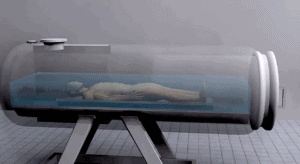Anyone who has looked into alternative forms of disposition has probably read that natural organic reduction (NOR), better known as human composting, is considered the most eco-friendly service that’s available today. The only problem is NOR has only been legalized in a limited number of states. Some also wonder if natural organic reduction is really that much greener than options like natural burial.
If you’re counting the number of carbon emissions being generated, then NOR is going to be extremely green. Let’s break it down and look at the different ways carbon emissions factor into disposition.
Energy Required for Human Composting
The facility has to have an energy supply to be operable, but the actual work of NOR is being done by microbes. Talk about a renewable energy source. Microbes are a type of bacteria, and bacteria is the most abundant thing on the planet.
Compare this to traditional funeral services and it’s evident NOR is less energy intensive. Traditional funeral services involve procedures and events that are excessive and waste energy. Conventional cremation is particularly harmful in terms of energy use and carbon emissions. After much analysis, it was determined a cremation generates around 418 pounds of carbon dioxide.
As far as the facility goes, NOR was developed to minimize the impact of disposition. Careful planning goes into making each facility as energy efficient as possible. Clean energy sources can also be used to further reduce carbon emissions. Because facilities are being built from the ground up, solar and other green technology is being utilized to make them carbon neutral.
Another alternative disposition is also much more energy efficient than traditional services. Water cremation uses far less energy than traditional burial and cremation. The service requires just one tenth the amount of energy that’s needed for conventional flame cremation. It’s an excellent option for families that want to receive cremains.
Resources Used for Human Composting
Here is where some people will call into question the eco-friendliness of natural organic reduction. Some people will point out that a lot of resources are required to build the natural organic composition facilities and vessels.
While that is a valid point, the long-term ecological costs are much lower considering that all funeral homes require a facility, and unlike caskets used for burial, the NOR vessels are reused. Overtime as more services are completed, the carbon emissions generated by the resources used to make NOR possible becomes lower.
One important thing that makes NOR environmentally friendly is that land resources aren’t needed. There is no burial at all with natural organic reduction, therefore there’s no land use. This is a very critical point in some cities where plots aren’t plentiful and there’s concern over land conservation.
Instead, natural organic reduction gives back to the land. The end result of the process is about 1 cubic yard of nutrient-dense soil that can aid in plant growth. It’s the exact opposite effect of traditional funeral services for an ecological standpoint.
Byproducts Generated by Human Composting
This is where natural organic reduction has the clear advantage. All types of disposition result in byproducts. They are a result of the process and can be extremely harmful to the environment. One of the worst byproducts is embalming fluid leaching into the ground after a traditional burial. And traditional flame cremation creates a fair amount of air pollution due to the incineration. Pollution is also created if unnatural items aren’t removed prior to the cremation, such as teeth fillings that contain mercury.
With natural organic reduction this isn’t the case. The byproduct of NOR is nutrient-rich compost. It’s something that nurtures the environment rather than poisoning it.
Another post-disposition factor is what’s done with the remains. Some families choose to make a keepsake or memento using cremains after a cremation. It’s a wonderful way to remember a loved up, but it does add to the overall carbon footprint. Resources are needed to make the keepsake. Just shipping a portion of the cremains to the service provider is going to create carbon emissions.
The soil from natural organic reduction is either used by the family, kept in a container or donated for conservation efforts. There’s little to no carbon emissions resulting from the use of NOR remains. In fact, if the soil is used to grow plants that remove carbon dioxide from the air it will actually reduce carbon emissions in the long run.
That’s the true beauty of natural organic reduction. It not only uses less energy and resources, which in turn reduces carbon emissions, it also has the potential to keep removing carbon from the atmosphere in an indirect way.
One last byproduct to consider is the carbon in our bodies. We are made up of about 18% carbon, which is why cremated remains contain it. The soil from natural organic reduction also contains carbon that is absorbed rather than being released into the air.
It’s estimated that each person who chooses natural organic reduction in lieu of traditional cremation or burial prevents one metric ton of carbon from being emitted. That’s a big difference, and it adds up with each person. We fully anticipate interest and demand for human composting will continue to increase in the coming years. As more people become familiar with what the process actually entails and the environmental benefits, we’re likely to see NOR become less of an alternative and more common practice.
If you’d like to know more about arranging natural organic reduction in Texas give our team a call, text or email when it’s most convenient for you. We can answer your questions or provide a custom quote for natural organic reduction services.






